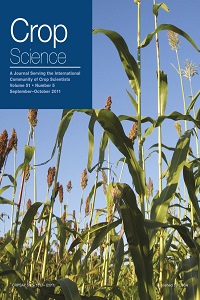Recurrent selection in a synthetic brachiariagrass population improves resistance to three spittlebug species
Spittlebugs (Homoptera: Cercopidae) are important pests of forage grasses in the genus Brachiaria (Trin.) Griseb. throughout the neotropics. Results of recurrent selection on resistance to spittlebugs in a synthetic brachiariagrass population are reported. The population was synthesized by recombining sexual hybrids obtained from crosses between a tetraploidized sexual ruzigrass (B. ruziziensis Germain & Evrard) biotype and nine natural apomictic tetraploid accessions of signalgrass (B. decumbens Stapf) and palisadegrass [B. brizantha (A. Rich.) Stapf]. The first three selection cycles were on resistance to a single Colombian spittlebug species [Aeneolamia varia (F.)], and the final two cycles simultaneously on resistance to A. varia and to two additional Colombian spittlebug species [A. reducta (Lallemand) and Zulia carbonaria (Lallemand)]. Selection was based on survival of spittlebug nymphs feeding on artificially infested, greenhouse-grown plants. From C2 to C6, mean survival of A. varia nymphs on selected genotypes dropped from 55.6 to 7.0%. Tetraploid sexual clones with combined high levels of resistance to all three spittlebug species have been obtained. The effectiveness of this resistance against spittlebug species not occurring in Colombia needs to be determined, and its expression in crosses with spittlebug-susceptible, apomictic genotypes needs to be assessed.

